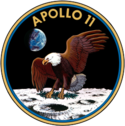Apollo 12
| Apollo 12 | |||
 | |||
| Statistik för uppdraget | |||
|---|---|---|---|
| Uppdrag | Apollo 12 | ||
| NSSDC-ID | Kommandomodul: 1969-099A[1] Månlandare: 1969-099C[2] | ||
| Anrop | Kommandomodul: Yankee Clipper Månlandare: Intrepid | ||
| Varaktighet | 10 dagar, 4 timmar, 36 minuter, 24 sekunder | ||
| Uppskjutning | |||
| Raket | Saturn V | ||
| Uppskjutningsramp | Kennedy Space Center LC 39A | ||
| Uppskjutning | 14 november 1969 16:22:00 UTC | ||
| Landning | |||
| Landning | 24 november 1969 20:58:24 UTC Stilla Havet 15°47′S 165°9′V / 15.783°S 165.150°V | ||
| Månen | |||
| Antal varv kring månen | 45 st | ||
| Tid i omloppsbana kring månen | 88 h 58 min 11.52 s | ||
| Månlandning | 19 november, 1969 06:54:35 UTC | ||
| Månprover, vikt | 34,35 kg | ||
| Antal månpromenader | 2 st | ||
| Månpromenader, längd | 7 timmar, 45 minuter, 18 sekunder | ||
| Tid på månen | 18 timmar | ||
| Landnings plats | Oceanus Procellarum | ||
| Dockning | |||
| Dockning | 14 november 1969, 19:48:53 UTC | ||
| Ur dockning | 19 november 1969, 04:16:02 UTC | ||
| Andra dockningen | 20 november 1969, 17:58:20 UTC | ||
| Andra ur dockning | 20 november 1969, 20:21:31 UTC | ||
| Besättning | |||
| Besättning | 3 | ||
| Befälhavare | Charles P. Conrad | ||
| Pilot | Richard F. Gordon (kommandomodulen) Alan L. Bean (månlandaren) | ||
 Fr.v: Conrad, Gordon och Bean | |||
| Kronologi | |||
| |||
Apollo 12 var det sjätte bemannade och det tolfte delprojektet i Apolloprogrammet. Apollo 12 var det andra bemannade rymdskeppet som landade på månen efter det berömda uppdraget Apollo 11.
Farkosten sköts upp med en Saturn V-raket från Kennedy Space Center den 14 november 1969. Charles Conrad och Alan Bean landade på månen den 19 november 1969. Efter att ha tillbringat ungefär 18 timmar på månen, påbörjade man resan tillbaka till jorden. Den 24 november 1969 landade man i Stilla Havet.
Uppdrag
Apollo 12 hade som uppdrag att återföra vissa delar från Surveyor 3, en obemannad rymdsond som landat på månen i april 1967 och man ville därför se hur månens omgivning hade påverkat månsonden. Dessutom tog man med sig 34 kg månmaterial.
Besättningen
- Charles P. Conrad, befälhavare
- Richard F. Gordon, pilot, kommandomodulen
- Alan L. Bean, pilot, månlandaren
Bilder
- Uppskjutningen
- Månlandaren Intrepid
- Conrad vid Surveyor 3 med Intrepid i bakgrunden
Se även
Referenser
Fotnoter
- ^ ”NASA Space Science Data Coordinated Archive” (på engelska). NASA. https://nssdc.gsfc.nasa.gov/nmc/spacecraft/display.action?id=1969-099A. Läst 27 mars 2020.
- ^ ”NASA Space Science Data Coordinated Archive” (på engelska). NASA. https://nssdc.gsfc.nasa.gov/nmc/spacecraft/display.action?id=1969-099C. Läst 27 mars 2020.
Källor
Externa länkar
 Wikimedia Commons har media som rör Apollo 12.
Wikimedia Commons har media som rör Apollo 12.
| |||||||||||||||||||||||||||||||||||||||||||
| |||||||||||||||||||||||||||||||||
Media som används på denna webbplats
Logo Apollo 13
This is the insignia of the Apollo 13 lunar landing mission. The Apollo 13 prime crew were the astronauts James A. Lovell Jr., commander; Thomas K. Mattingly II, command module pilot; and Fred W. Haise Jr., lunar module pilot. Represented in the Apollo 13 emblem is Apollo, the sun god of Greek mythology, symbolizing how the Apollo flights have extended the light of knowledge to all mankind. The Latin phrase Ex Luna, Scientia means "From the Moon, Knowledge." Apollo 13 was intended to be the National Aeronautics and Space Administration's (NASA) third lunar landing mission.
Författare/Upphovsman: Pascal (Flickr user: pasukaru76), Licens: CC0
Vostok spacecraft replica at the Technik Museum Speyer, Germany.
Portrait of the prime crew of the Apollo 12 lunar landing mission. From left to right they are: Commander, Charles "Pete" Conrad Jr.; Command Module pilot, Richard F. Gordon Jr.; and Lunar Module pilot, Alan L. Bean. The Apollo 12 mission was the second lunar landing mission in which the third and fourth American astronauts set foot upon the Moon. This mission was highlighted by the Lunar Module nicknamed "Intrepid" landing within a few hundred yards of a Surveyor probe which was sent to the Moon in April of 1967 on a mapping mission as a precursor to landing.
This is the official crew insignia for Apollo 12, the United States' second lunar landing mission. Crew members are astronauts Charles Conrad Jr., commander; Richard F. Gordon Jr., command module pilot; and Alan L. Bean, lunar module pilot. The clipper ship signifies that the crew is all Navy and symbolically relates the era of the clipper ship to the era of space flight. As the clipper ship brought foreign shores closer to the United States and marked the increased utilization of the seas by this nation, spacecraft have opened the way to the other planets and Apollo 12 marks the increased utilization of space-based on knowledge gained in earlier missions. The portion of the moon shown is representative of the Ocean of Storms area in which Apollo 12 will land.
Apollo 12 This image from LRO shows the spacecraft's first look at the Apollo 12 landing site. The Intrepid lunar module descent stage, experiment package (ALSEP) and Surveyor 3 spacecraft are all visible. Astronaut footpaths are marked with unlabeled arrows. This image is 824 meters (about 900 yards) wide. The top of the image faces North. Photo is taken by the artificial satellite Lunar Reconnaissance Orbiter in 2009
Apollo 12 - Surveyor 3 and Conrad
Apollo 12 lunar module on the Moon.


















